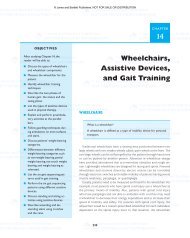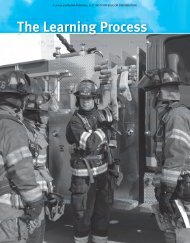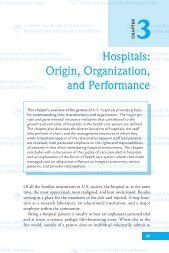CHAPTER - Jones & Bartlett Learning
CHAPTER - Jones & Bartlett Learning
CHAPTER - Jones & Bartlett Learning
Create successful ePaper yourself
Turn your PDF publications into a flip-book with our unique Google optimized e-Paper software.
30017_CH15_398_431_r7.qxp 4/7/06 3:13 PM Page 415<br />
© <strong>Jones</strong> and <strong>Bartlett</strong> Publishers. NOT FOR SALE OR DISTRIBUTION<br />
of public policy, the boundaries between organized<br />
and white-collar crimes will continue to blur because<br />
of inconsistent definitions of these terms and<br />
the increasing number of new crimes (such as cyber<br />
crimes) that add to the complexities of enforcement.<br />
The public demands stricter enforcement of<br />
these crimes and punishment of these offenders, although<br />
allocated resources continue to be limited<br />
and focus more on street crimes. 69<br />
Expanded Definitions<br />
of White-Collar Crime<br />
Sutherland’s original definition of white-collar crime<br />
has been criticized. Indeed, criminologists have had<br />
some problems with accurately defining whitecollar<br />
crime and in adequately capturing all its nuances<br />
and describing its many forms. 70 Although<br />
his sample included 70 of the largest manufacturing,<br />
mining, and mercantile corporations in 1929<br />
and 1938, Sutherland’s definition focused on the<br />
individual white-collar criminal and did not consider<br />
corporations or organizations acting as a<br />
whole. This creates a dichotomy in the definition<br />
of white-collar crime: crimes committed by (for)<br />
and against the organization. 71<br />
The earliest studies of white-collar criminality<br />
feature crimes committed by organizations. For example,<br />
Clinard’s study of pricing and rationing violations<br />
during World War II found that businesses<br />
committed 338,029 violations during 1944 alone.<br />
Although agreeing that differential association could<br />
explain some violations, Clinard argued that the personality<br />
of the violator also accounted for the<br />
crime. 72<br />
Similarly, Hartung’s investigation of the wholesale<br />
meat industry in Detroit, 73 Quinney’s analysis<br />
of the violations of retail pharmacists, 74 and Geis’<br />
study of antitrust violations by manufacturers of<br />
heavy electrical equipment 75 all examined crimes<br />
committed by organizations. Studies that followed<br />
dealt with this dichotomy directly by expanding<br />
the definition of white-collar crime to include corporate<br />
criminality.<br />
Shapiro argues that white-collar crime should<br />
be viewed as an abuse of trust. From this perspective,<br />
white-collar criminals typically hold monopolies<br />
of information that cannot be verified by their<br />
clients. Clients are separated from the perpetrators<br />
both physically and socially. Often, they act in a<br />
collective fashion as a bank, charity, or company.<br />
Usually, their activities are hidden and difficult to<br />
follow. Thus, lying, stealing, misappropriation, selfdealing,<br />
and corruption are violations of a relationship<br />
based on trust. 76<br />
In effect, the definition of white-collar crime<br />
has been split in two: occupational crime and corporate<br />
crime.<br />
Occupational Crime<br />
Gary Green defines occupational crime as “any act<br />
punishable by law that is committed through opportunity<br />
created in the course of an occupation that is<br />
legal.” 77 He also sets up a typology that focuses on<br />
the beneficiary of the crime and separates the offenders<br />
motivated by a desire for individual gain from<br />
those who act on behalf of the organization. Occupational<br />
crime can be divided into four major types: 78<br />
1. Crimes committed for the benefit of an employing<br />
organization. Here, the employers, not the individuals,<br />
benefit directly from the offense. Insurance<br />
fraud in auto body repair is an example<br />
of this type of crime. Paul Tracy and James Fox<br />
conducted an experiment in which four drivers<br />
took their damaged autos to 96 repair shops in<br />
Massachusetts. Repair estimates were about<br />
one third higher for drivers who said they were<br />
covered by insurance than for those who said<br />
they were not. This finding held despite the<br />
type of car, the extent of the damage, the sex of<br />
the driver, and the location of the shop. 79<br />
2. Crimes committed as the result of state-based<br />
authority. To commit this type of crime, the offender<br />
must be “legally vested with governmental<br />
powers to make or enforce laws or to<br />
command others.” 80 Chambliss defines stateorganized<br />
crime as acts defined by law as criminal<br />
and committed by state officials in the<br />
pursuit of their job as representatives of the<br />
state. For example, CIA support of opiumgrowing<br />
feudal lords in the mountains of Vietnam,<br />
Laos, Cambodia, and Thailand during and<br />
after the Vietnam War represented occupational<br />
crime. Chambliss also includes arms smuggling<br />
(e.g., U.S. government arms sales to the<br />
Nicaraguan Contras) and state-organized assassinations<br />
(e.g., a CIA-sponsored coup in Chile<br />
that resulted in the assassination of socialist<br />
President Salvador Allende) in this category.<br />
3. Crimes committed by professionals in their professional<br />
capacity. These crimes are a direct result of<br />
the trust that others have vested in certain indi-<br />
1<br />
2<br />
3<br />
4<br />
5<br />
6<br />
7<br />
8<br />
9<br />
10<br />
11<br />
12<br />
13<br />
14<br />
15<br />
16<br />
17<br />
18<br />
19<br />
20<br />
21<br />
22<br />
23<br />
24<br />
25<br />
26<br />
27<br />
28<br />
29<br />
30<br />
31<br />
32<br />
33<br />
34<br />
35<br />
36<br />
37<br />
38<br />
39<br />
40<br />
41<br />
42<br />
43<br />
44<br />
45<br />
46<br />
47<br />
48<br />
49<br />
50<br />
51<br />
52<br />
White-Collar Crime 415<br />
1st pass Pages

















